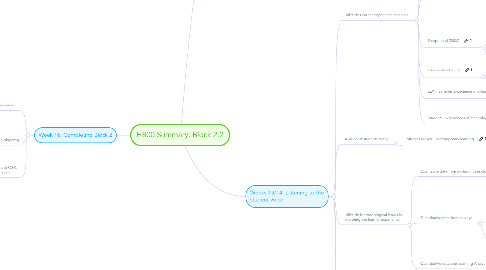
1. Week 12: Students’ approaches to learning and teachers’ approaches to teaching
1.1. Students’ approaches to learning and teachers’ approaches to teaching in higher education, Richards 2005
1.1.1. Definitions of learning revisited
1.2. Technology use in learning
1.2.1. Price et al. begin by pointing out that technology is being used for two different purposes in higher education: 1. to deliver the curriculum (the horizontal axis in Figure 1) 2. to provide student support (the vertical axis).
1.2.2. online tuition is a pastoral activity and not a purely academic activity, Price et al
1.3. Effectiveness of tutorial support
1.3.1. Face-to-face versus online tutoring support in humanities courses in distance education’, Richardson 2009
1.4. Student experience research
1.4.1. The author argues that surveys of the student experience are vulnerable to different kinds of response bias, which means, among other things, that the results may give too positive a view of the student experience. Yorke, M. (2009)
2. Week 16: Completing Block 2
2.1. Assessment
2.1.1. I would […] dare to say that we’re in probably […] one of the biggest periods of change with regard to assessment in higher education that we’ve ever seen. David Boud (2008)
2.2. More on blogging
2.2.1. More on blogging
2.2.1.1. An empirically grounded framework to guide blogging in higher education
2.2.1.2. Investigating the individual difference antecedents of perceived enjoyment in students’ use of blogging, Wang 2010
2.3. Distance teaching and OER: how well do they travel?
3. Weeks 13/14: Listening to the student voice
3.1. Learner experience research
3.1.1. Oblinger and Oblinger (2005)
3.1.1.1. Technologies are ‘interwoven’ through all aspects of the lives of the Net Generation; The Net Generation has grown up with technology;Use and ownership of technologies is becoming near ubiquitous;Students use the web extensively for homework.
3.1.1.2. Individuals raised with the computer deal with information differently compared to previous cohorts: ‘they develop hypertext minds, they leap around’. A linear thought process is much less common than bricolage, or the ability to piece information together from multiple sources.
3.1.2. Kennedy et al (2008)
3.1.2.1. [Students were] very tech-savvy. Many students are using a wide range of traditional and emerging technologies regularly in their daily lives. However, there are clearly areas where the use of and familiarity with technology-based tools is far from universal among first year students.
3.1.2.2. At the time of growing interest in the attributes of the so-called ‘NetGeneration’, it is particularly important for universities to ensure that decision-making about how to enhance the learning of incoming university students is evidence-based and empirically informed.
3.1.3. Sharpe et al (2005)
3.1.3.1. suggested that there was a scarcity of studies focusing on the learner voice (beyond that of simple module evaluations
3.1.3.2. elearning research has tended to give far more emphasis to the practitioner perspective and to module design
3.1.4. Thorpe et al (2008)
3.1.4.1. Suggest there is plenty of research
3.1.5. LEX - learniner experience of e-learning
3.1.5.1. The findings led to the development of a conceptual framework, which mapped five high-level categories (life, formal learning, technology, people and time) against five influencing dimensions (control, identity, feelings, relationships and abilities).
3.1.6. Students’ experiences of technologies (LXP)
3.1.6.1. the Web is unequivocally the first port of call for students – with extensive examples across the study of how students are using search engines, dedicated subject-specific sites and e-journals to find information of relevance to their studies.
3.2. A vision of students today
3.2.1. Michael Wesch - contemporary learning
3.3. Methodological issues in exploring the learner experience
3.3.1. Qualitative data from in-depth case studies
3.3.1.1. Audio logs, e.g. LXP
3.3.1.2. Vidoe logs, e.g. LEX
3.3.1.3. Theoretical frameworks - perspectives
3.3.1.3.1. Activity Theory (Engeström et al., 1999)
3.3.1.3.2. Wenger’s Community of Practice
3.3.2. Quantitative data from surveys
3.3.2.1. Edinburgh University, for example, has been surveying students’ use of technologies since the early 1990s, and EDUCAUSE launched its first survey of student technology choices and preferences in 2004
3.3.2.2. Computer based task switching, Judd and Kennedy (2011)
3.3.3. Quantitative data and Learning Analytics
3.3.3.1. Analytics is the use of data, statistical analysis, and explanatory and predictive models to gain insights and act on complex issues. (Bichsel, 2012, p. 6)
3.3.3.2. Building Organizational Capacity for Analytics , Norris and Baer’s 2013
3.4. Work-related ICT and a relational approach to learning
3.4.1. Learners’ experience of blended learning in practice-based learning contexts (PB-LXP)
3.4.1.1. ICT and practice learning
3.4.1.1.1. Richardson, J.T.E. (2005) ‘Students’ approaches to learning and teachers’
3.4.1.1.2. A relational view of learning
3.4.1.2. Factors influencing learning outcomes
3.4.2. Teaching is also influenced by context
3.5. Critical views of the net generation
3.5.1. Digital natives (Prensky) vs Net generation (tapsoctt) vs Millenials (Obinger and Obinger)
3.5.2. An investigation of differences in undergraduates’ academic use of the internet.
3.5.3. The ‘digital natives’ debate: a critical review of the evidence. , Bennet et al (2008)
3.5.4. Digital Na(t)ives? Variation in internet skills and uses among members of the ‘Net Generation’
